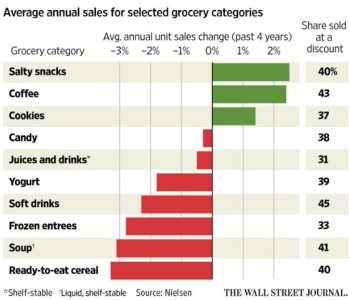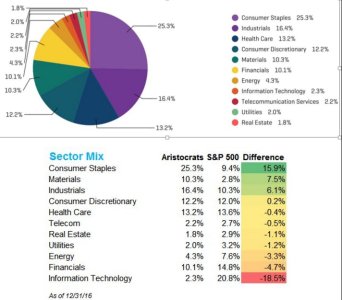sempre su:
Big Food Faces Pressure From Retailers Demanding Discounts - WSJ
America’s packaged-food companies are coming under pressure from retailers who are pushing big brands to lower their prices. On Thursday, Campbell Soup Co.said its sales would suffer this winter because it failed to reach an agreement with a major retailer over promotional pricing and shelf space for its canned soup, its most important product. The unsuccessful negotiations were with Wal-Mart Stores Inc., according to people familiar with the situation. Wal-Mart comprises about 20% of Campbell’s annual sales. Grocery giants, including Wal-Mart and Target Corp. , as well as smaller chains such as Sprouts Farmers Market Inc. are vying to find ways to attract shoppers amid intensifying competition. Amazon.com Inc.’s deeper push into the grocery business with its acquisition of Whole Foods Market Inc. is the latest entrant into an already crowded sector.
Packaged-food companies have been struggling with declining sales for years as shoppers move away from older brands and toward food options perceived as fresher and healthier. Now retailers are adding to the packaged-food companies’ woes. “The retailer landscape is changing dramatically,” Campbell Chief Executive Denise Morrison told analysts on Thursday as the company reported its 11th straight quarter of falling sales. Campbell said negotiations for promotions with retailers involve decisions on pricing, product assortment and other factors, but the company declined to provide details of its recent issue. Campbell’s shares fell nearly 7% on Thursday, the biggest loser in the S&P 500 index.
Wal-Mart is pushing hard to lower prices to compete. Executives at the world’s largest retailer by revenue have told suppliers that its prices should be 15% lower than competitors’ 80% of the time. At the same time, Wal-Mart is spending billions to drop prices strategically on certain products, eating into its own margins to lower prices, sometimes without telling brands in advance, according to managers at large consumer-goods companies that sell through Wal-Mart. When one retailer drops prices, that can challenge brands because other retailers will ask suppliers to match. Kroger Co. , the largest traditional grocer in the U.S., is scheduled to report earnings next week, likely providing additional insight into the tug of war between retailers and brands. Disagreements over the terms of in-store promotions are common but become heightened when retailers are feeling squeezed, and they can be particularly tough in a struggling category like canned soup, said Mathis Martines, vice president of brand and strategy for the Concentric consultancy. “You are seeing the degradation of some of these larger, mature brands,” he said. Hain Celestial Group Inc.’s chief executive, Irwin Simon, said Tuesday that retailers of all kinds are asking for reduced prices. His company, which sells BluePrint refrigerated juice and Terra vegetable chips, reported better-than-expected sales, but he said: “Everyone wants to sell more; everyone wants to cut prices.”
Warren Buffett, an investor and board member of Campbell’s rival Kraft Heinz Co., said Wednesday that the struggle between brands and retailers has been going for decades, but as grocers such as Wal-Mart, Costco Wholesale Corp. and Amazon get stronger, brands have less power to negotiate. “Right now, the retailers, they’re doing better in this round of the fight,” he said in an interview with CNBC.
General Mills Inc., Kellogg Co. and Kraft Heinz say that about one-fifth of their annual sales come from Wal-Mart, giving the retail giant leverage over the biggest food makers in the country. General Mills, which could benefit from Campbell’s loss with its rival Progresso soup brand, declined to comment, as did Kraft Heinz Co. Kellogg didn’t immediately comment. Amazon, which completed its acquisition of Whole Foods on Monday, immediately lowered prices on items such as baby kale and bananas in stores and made more items available online. European discount chains such as Aldi and Lidl are becoming more popular in the U.S., cutting into mainstream grocery sales, by offering lower prices. Campbell’s Ms. Morrison said the industry will remain “hypercompetitive” for the foreseeable future, affected by alternatives to grocery stores such as online shopping with Amazon.com Inc.’s acquisition of Whole Foods and meal-kit services such as Blue Apron Holdings Inc. Campbell is trying to diversify, buying brands such as Pacific Foods organic soup and Bolthouse Farms refrigerated juice. But mainstays such as Pepperidge Farm Goldfish crackers, V8 juice and SpaghettiOs still make up about 85% of Campbell’s $1.67 billion in quarterly sales. Campbell’s sales slid 1.4% in the quarter ended July 30, and its adjusted earnings per share were 52 cents, below analysts’ expectations. The company cut costs in the quarter, with adjusted marketing and promotional expenses down 12%. At J.M. Smucker Co. , which sells Jif peanut butter and Folgers coffee among other brands, price is a key factor for retailers now, Chief Mark Smucker said last week following its earnings. “They are competing, they’re trying to find points of difference. Obviously, price to them is one of those.” Sprouts, a natural-food chain that rivals Whole Foods, said it was forced into cutting prices and offering more promotional deals in the recent quarter because of competition. “It’s heavy ad and in-store promotions,” said Brad Lukow, chief financial officer at Sprouts, during earnings in August. Smart & Final Stores , Inc., a California warehouse-format grocer, said it has increased its mailed fliers on markdowns of key items, given the competition. Discounts and promotions like buy-one-get-one-free deals are crucial for sales growth, particularly in categories that aren’t expanding, such as cereal and frozen meals. About 40% of cereal boxes and 33% of frozen meals are sold on a promotion, according to Nielsen. Bob Goldin, a partner at food industry consultancy Pentallect Inc., said the heavy promotional environment is “an intractable problem” in retail. “Constant discounting depresses everyone’s margins; it also trains consumers only to shop on deal,” he said. Campbell, and other brands, can push back, but retailers have the upper hand because they control the shelf space, Mr. Goldin said.

va bene per niente, così cambia anche il rendimento



